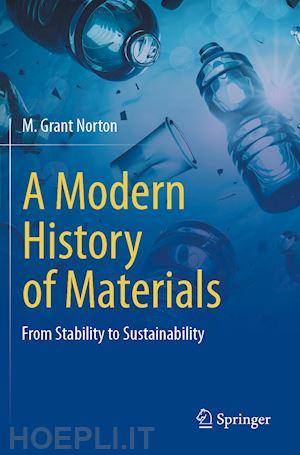

Se ordini entro 22 ore e 31 minuti, consegna garantita in 48 ore lavorative
scegliendo le spedizioni Express
Questo prodotto usufruisce delle SPEDIZIONI GRATIS
selezionando l'opzione Corriere Veloce in fase di ordine.
Pagabile anche con Carta della cultura giovani e del merito, 18App Bonus Cultura e Carta del Docente
What could the ancient Egyptians tell us about 3D printing? How can we make lithium-ion batteries greener and more sustainable? Which materials will form the heart of future quantum computers?
Plastic films, glass optical fibers, silicon crystals, and more — this book is about the history of the materials that have rapidly transformed our society over the last century and their role in the major global challenges of the future. From metal alloys ushering in a new age of industry to advanced materials laying the atomic brickwork of the Digital Revolution, the book examines the societal impact of the modern materials revolution through the twin lenses of stability and sustainability.
Why aren’t maglev trains mainstream? Whatever happened to graphene and carbon nanotubes? The book also looks at the unmet promises of some of the most exciting — and hyped — technologies in recent decades — superconductivity and nanotechnology. The final chapter reviews our history of materials usage, the increasing demand for many critical raw materials, and addresses the upcoming new challenges for creating a circular economy based on reusing and recycling materials.Introduction.- Chapter 1 – A Measure of Stability.- Chapter 2 – A Quantum of Solace.- Chapter 3 – Seeing is Believing.- Chapter 4 – Made to Measure.- Chapter 5 – There’s Still Plenty of Room at the Bottom.- Chapter 6 – The Future of Mobility.- Chapter 7 – Here Comes the Sun.- Chapter 8 – Certain about Uncertainty.- Chapter 9 – Promises Unmet.- Chapter 10 – A Green New Deal.- Final Thoughts.
Professor Norton’s research is primarily focused on applications of nanomaterials in clean energy and the life sciences. He is author or co-author of over 200 papers in the archival literature, several book chapters and patents, two textbooks including Ceramic Materials: Science and Engineering, and most recently the popular science book Ten Materials that Shaped our World. He serves as Deputy Editor-in-Chief of Journal of Materials Science and on the International Editorial Board of Journal of Materials Education.
Prior to entering academia, he worked for two major European multinationals: Cookson Group PLC and Heraeus GmbH. He has consulted for a number of companies and organizations including the United States Air Force and REC Silicon, the world’s largest producer of silicon materials. From 2009 to 2011, he was on the Board of Directors of the Washington Technology Center (a gubernatorial appointment). He currently serves on several boards including the advisory board for the Thomas S. Foley Institute for PublicPolicy and Public Service and the Engineering Accreditation Commission of ABET.










Il sito utilizza cookie ed altri strumenti di tracciamento che raccolgono informazioni dal dispositivo dell’utente. Oltre ai cookie tecnici ed analitici aggregati, strettamente necessari per il funzionamento di questo sito web, previo consenso dell’utente possono essere installati cookie di profilazione e marketing e cookie dei social media. Cliccando su “Accetto tutti i cookie” saranno attivate tutte le categorie di cookie. Per accettare solo deterninate categorie di cookie, cliccare invece su “Impostazioni cookie”. Chiudendo il banner o continuando a navigare saranno installati solo cookie tecnici. Per maggiori dettagli, consultare la Cookie Policy.